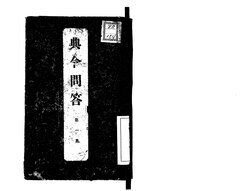File:NDL843723 典令問答 第1集.pdf

Original file (7,987 × 6,112 pixels, file size: 137.84 MB, MIME type: application/pdf, 75 pages)
Captions
Captions
Summary
[edit]| 典令問答
( |
|||||||||||||||||||||||||||
|---|---|---|---|---|---|---|---|---|---|---|---|---|---|---|---|---|---|---|---|---|---|---|---|---|---|---|---|
| Author |
軍事新報編集部 |
||||||||||||||||||||||||||
| Title |
典令問答 |
||||||||||||||||||||||||||
| Volume | 第1集 | ||||||||||||||||||||||||||
| Publisher |
軍事教育会 |
||||||||||||||||||||||||||
| Language | jpn | ||||||||||||||||||||||||||
| Publication date |
1899 明32.9 |
||||||||||||||||||||||||||
| Place of publication | JP | ||||||||||||||||||||||||||
| Source |
institution QS:P195,Q477675 |
||||||||||||||||||||||||||
| Creator InfoField | 軍事新報部 編 | ||||||||||||||||||||||||||
| Publication Place InfoField | 東京 | ||||||||||||||||||||||||||
| Subject: NDC InfoField | 396 | ||||||||||||||||||||||||||
| Extent InfoField | 124p ; 20cm | ||||||||||||||||||||||||||
| Material Type InfoField | Book | ||||||||||||||||||||||||||
| Source Identifier: JPNO InfoField | 40064844 | ||||||||||||||||||||||||||
| Audience InfoField | 一般 | ||||||||||||||||||||||||||
| Title Transcription InfoField | テンレイ モンドウ | ||||||||||||||||||||||||||
| Volume Transcription InfoField | 1 | ||||||||||||||||||||||||||
| Publisher Transcription InfoField | グンジ キョウイクカイ | ||||||||||||||||||||||||||
| Source Identifier: NDLBibID InfoField | 000000482272 | ||||||||||||||||||||||||||
| Call Number InfoField | 82-154 | ||||||||||||||||||||||||||
| Creator: NDLNAId InfoField | 00769869 | ||||||||||||||||||||||||||
| Note InfoField | 国立国会図書館内では、一部分のみ印刷できます。 | ||||||||||||||||||||||||||
| Contents InfoField | 目次 勲章佩用に就て/126 | ||||||||||||||||||||||||||
Licensing
[edit]This image is in the public domain because it is a mere mechanical scan or photocopy of a public domain original, or – from the available evidence – is so similar to such a scan or photocopy that no copyright protection can be expected to arise. The original itself is in the public domain for the following reason:
This tag is designed for use where there may be a need to assert that any enhancements (eg brightness, contrast, colour-matching, sharpening) are in themselves insufficiently creative to generate a new copyright. It can be used where it is unknown whether any enhancements have been made, as well as when the enhancements are clear but insufficient. For known raw unenhanced scans you can use an appropriate {{PD-old}} tag instead. For usage, see Commons:When to use the PD-scan tag. |
著作権法第67条第1項により文化庁長官裁定を受けて公開(裁定年月日: 2019/01/25)
File history
Click on a date/time to view the file as it appeared at that time.
| Date/Time | Thumbnail | Dimensions | User | Comment | |
|---|---|---|---|---|---|
| current | 18:47, 2 January 2024 |  | 7,987 × 6,112, 75 pages (137.84 MB) | Wmr-bot (talk | contribs) | 上載《843723.pdf》 |
You cannot overwrite this file.
File usage on Commons
The following page uses this file:
Metadata
This file contains additional information such as Exif metadata which may have been added by the digital camera, scanner, or software program used to create or digitize it. If the file has been modified from its original state, some details such as the timestamp may not fully reflect those of the original file. The timestamp is only as accurate as the clock in the camera, and it may be completely wrong.
| Short title | |
|---|---|
| Author | |
| Keywords | https://commons.wikimedia.org/wiki/Commons:Library_back_up_project |
| Conversion program | PyPDF2 |
| Encrypted | yes (print:yes copy:no change:no addNotes:no algorithm:AES-256) |
| Page size | 3834 x 2934 pts |
| Version of PDF format | 1.7 |




